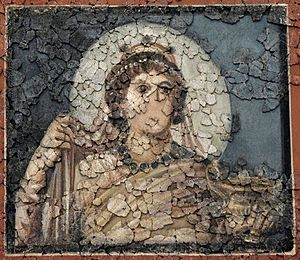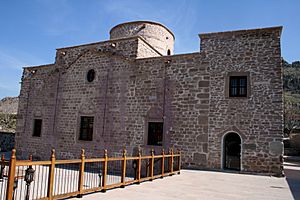Helena of Constantinople facts for kids
Quick facts for kids Helena |
|||||||||
|---|---|---|---|---|---|---|---|---|---|
| Augusta | |||||||||
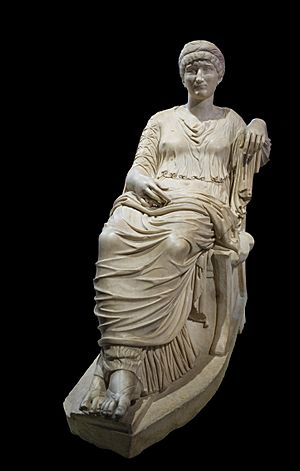
Seated statue of Helena in Musei Capitolini, Rome
|
|||||||||
| Roman empress | |||||||||
| Born | c. AD 246/48 Drepanon (later Helenopolis), Bithynia, in Asia Minor (modern-day Hersek, Altınova, Yalova, Turkey) |
||||||||
| Died | c. AD 330 Rome, Tuscania et Umbria (modern-day Italy) |
||||||||
| Burial | Mausoleum of Helena | ||||||||
| Spouse | Constantius Chlorus | ||||||||
| Issue | Constantine I | ||||||||
|
|||||||||
| Dynasty | Constantinian | ||||||||
| Religion | Nicene Christianity | ||||||||
Flavia Julia Helena Augusta (born around AD 246/248 and died around 330) was an important Empress of the Roman Empire. She is best known as the mother of Constantine the Great, who became a powerful Roman Emperor.
Helena is a very important person in the history of Christianity. Towards the end of her life, she went on a special religious trip to places like Syria Palaestina and Jerusalem. During this journey, an old story says she found the True Cross, which is believed to be the cross Jesus was crucified on. Many Christian churches, like the Eastern Orthodox Church and the Catholic Church, honor her as a saint.
Contents
Early life of Helena
Helena was likely from Greece, probably from a part of Asia Minor that is now Turkey. Her birthplace was probably a town called Drepanum, which was later renamed Helenopolis. Historian Eusebius of Caesarea wrote that she was born between 246 and 249 AD.
She came from a humble background, meaning she was not born into a rich or powerful family. A bishop named Ambrose of Milan, who wrote in the late 300s, was the first to call her a stabularia. This word can mean "stable-maid" or "inn-keeper."
Some popular stories, told by writers like Geoffrey of Monmouth, say that Helena was a British princess. They claimed she was the daughter of "Old King Cole" from the area of Colchester. However, this is a legend and not a historical fact.
Marriage to Emperor Constantius
It's not known exactly where Helena first met Constantius, who would later become an emperor. One story says they were wearing matching silver bracelets when they met. Constantius supposedly felt she was his soulmate.
Some historians believe that Constantius and Helena were not officially married. They might have had a common-law marriage, which was a recognized partnership but not a formal wedding.
Helena gave birth to her son, Constantine I, on February 27, probably around 272 AD. At that time, she was in a city called Naissus, which is now Niš in Serbia.
Later, Constantius wanted to marry a woman from a higher social class. So, he divorced Helena before 289 AD. He then married Theodora, who was the stepdaughter of Emperor Maximian.
Helena never married again. For a while, she lived a quiet life in Nicomedia, close to her only son. Constantine cared deeply for his mother.
Helena's return to public life
Constantine became the Emperor of the Roman Empire in 306 AD, after his father passed away. His mother, Helena, was brought back into public life in 312 AD and returned to the imperial court.
She is shown in the Eagle Cameo, a special carving that shows Constantine's family. This carving probably celebrated the birth of Constantine's son, Constantine II, in 316 AD. Helena was given the important title of Augusta in 325 AD. She became a Christian soon after her son became emperor.
Helena's religious journey and discoveries
Emperor Constantine gave his mother, Helena, the title of Augusta Imperatrix. This meant she had great power and could use the imperial treasury (the emperor's money) without limits. Her goal was to find important objects related to the Christian faith.
Between 326 and 328 AD, Helena traveled to Palestine.
She ordered the building of several churches, including the Church of the Nativity in Bethlehem and the Church of Eleona on the Mount of Olives. A story also says that Helena ordered a church to be built in Egypt to mark the spot of the Burning Bush on Mount Sinai.
The chapel at Saint Catherine's Monastery in Sinai, often called the Chapel of Saint Helen, was built around 330 AD.
The True Cross and the Church of the Holy Sepulchre
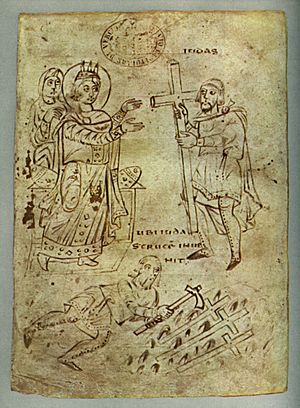
Jerusalem was still being rebuilt after it was destroyed by Titus in 70 AD. Emperor Hadrian had built a temple to Venus in the 130s over what was believed to be Jesus' tomb near Calvary. He had also renamed the city Aelia Capitolina.
Helena ordered this temple to be destroyed. She then chose a spot to begin digging.
A legend says that Helena had a dream. In her dream, she was told to make a large bonfire. The smoke from the fire would show her where the True Cross was buried. So, she told the people of Jerusalem to bring wood and make a huge pile. After adding frankincense (a type of incense) to it, the bonfire was lit. The smoke rose high into the sky and then came back down to the exact spot where the Cross had been buried.
Three different crosses were found. According to the story, Helena performed a test. She had a woman who was very sick and near death brought to her. When the woman touched the first and second crosses, her condition did not change. But when she touched the third cross, she suddenly got better! Helena then declared that this third cross was the True Cross.
At the place where the cross was found, Constantine ordered the building of the Church of the Holy Sepulchre. Other churches were also built at sites Helena discovered.
Helena is also said to have found the nails from the crucifixion. To use their special power to help her son, Helena supposedly had one nail placed in Constantine's helmet and another in the bridle of his horse. Another tradition says Helena found the Holy Tunic (Jesus' robe) during her trip to Jerusalem and sent it to Trier.
Cyprus
Several religious items believed to have been found by Helena are now in Cyprus, where she spent some time. These include parts of Jesus Christ's tunic, pieces of the holy cross, and pieces of the rope used to tie Jesus on the Cross.
The rope, which is considered a very rare item, is kept at the Stavrovouni Monastery. This monastery is also said to have been founded by Helena.
Rome
Helena left Jerusalem and the eastern provinces in 327 AD to return to Rome. She brought large parts of the True Cross and other holy items with her. These were then stored in her palace's private chapel and can still be seen today.
Her palace was later turned into the Basilica of the Holy Cross in Jerusalem. This church has been cared for by Cistercian monks for centuries.
Death and burial
Helena died around 330 AD, with her son Constantine by her side.
She was buried in the Mausoleum of Helena, a special tomb outside Rome on the Via Labicana road. Her sarcophagus (a stone coffin) is on display in the Pio-Clementine Vatican Museum in the Vatican. However, in 1154, her remains were moved to Santa Maria in Ara Coeli church, and the sarcophagus was used for Pope Anastasius IV.
Sainthood
| Saint Helena of Constantinople |
|
|---|---|
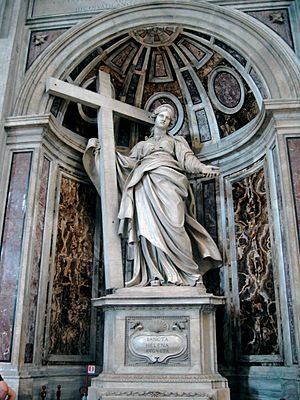
Statue of Saint Helena in St. Peter's Basilica, Rome, Italy
|
|
| Empress, Mother of Saint Constantine, Equal to the Apostles, Protector of the Holy Places | |
| Venerated in | |
| Canonized | Pre-Congregation |
| Major shrine | The shrine to Saint Helena in St. Peter's Basilica |
| Feast |
|
| Attributes | Crown Cross Nails |
| Patronage | archaeologists, converts, difficult marriages, divorced people, empresses, Saint Helena island, new discoveries, Noveleta, Cavite |
Helena is considered a saint by many Christian churches. These include the Eastern Orthodox Church, Oriental Orthodox churches, Eastern and Roman Catholic churches, and also the Anglican Communion and Lutheran Churches.
Her feast day (a day to celebrate her) in the Eastern Orthodox Church is on May 21, celebrated with her son. In the Roman Catholic Church, her feast day is on August 18. The Coptic Orthodox Church celebrates her on May 4 (9 Pashons in their calendar).
Some Anglican and Lutheran churches also celebrate her on May 21. The Church of England honors her on May 21, while the Episcopal Church celebrates her on May 22.
In the Ethiopian and Eritrean Orthodox Tewahedo Churches, the festival of Meskel remembers her discovery of the cross. It is celebrated on September 27 (or September 28 in leap years) with a large bonfire called a Demera.
The "Uncovering of the Precious Cross and the Precious Nails" by Saint Helen in Jerusalem is celebrated on March 6.
She is also remembered every Bright Wednesday along with saints from Mount Sinai by the Russian Orthodox Church and the Orthodox Church in America.
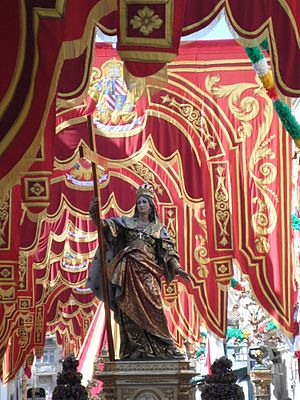
Relics
Helena's supposed skull is displayed in the Cathedral of Trier in Germany. Parts of her relics are also found at the basilica of Santa Maria in Ara Coeli in Rome, the Église Saint-Leu-Saint-Gilles in Paris, and at the Abbaye Saint-Pierre d'Hautvillers.
The church of Sant'Elena in Venice claims to have the complete body of the saint enshrined under its main altar.
Interesting facts about Helena
- Her name appears on old coins as Flavia Helena, Flavia Julia Helena, and sometimes Aelena.
- She is sometimes called Helen of Constantinople to tell her apart from others with similar names. In Hungarian, her name is "Ilona," and in Malta, it's "Liena."
- Her son Constantine renamed the city Bithynia to "Helenopolis" after her death around 330 AD.
- There were also cities named Helenopolis in Palestine and Helenopolis in Lydia. These cities, and the province of Helenopontus, were probably all named after Constantine's mother.
- Helena was about 80 years old when she returned from Palestine.
- According to tradition, Helena is responsible for the large number of cats in Cyprus. Local stories say she brought hundreds of cats from Egypt or Palestine in the fourth century to get rid of snakes in a monastery. This monastery is now known as "St. Nicholas of the Cats" and is near Limassol.
- 135 churches in England were dedicated to her, many around the area of Yorkshire.
- At least twenty-five holy wells (natural springs believed to have healing powers) in the United Kingdom are dedicated to Saint Helen.
- She is also the patron saint of Abingdon and Colchester in Great Britain.
- St Helen's Chapel in Colchester was believed to have been founded by Helena herself. Since the 15th century, Colchester's coat of arms has shown a picture of the True Cross and three crowned nails in her honor.
- Helena is the patron saint of new discoveries.
Later cultural traditions
In British folklore
In Great Britain, a later legend, made popular by Geoffrey of Monmouth, claimed that Helena was the daughter of the King of Britain, Cole of Colchester. This story says that King Cole allied with Constantius to avoid more war between the Britons and Rome. Helena was raised like a queen because she had no brothers to inherit the throne of Britain. The legend suggests Constantine learned about Christianity in Britain. However, this story has no historical proof.
Filipino legend and tradition
The Flores de Mayo festival in the Philippines honors Helena and her son Constantine for finding the True Cross. It includes a parade with floral and river-themed floats, showing Helena, Constantine, and others who followed her journey to find the True Cross. Filipinos call this parade Sagala.
Helena in fiction
Helena is the main character in Evelyn Waugh's 1950 novel Helena. She is also a main character in Priestess of Avalon (2000), a fantasy novel by Marion Zimmer Bradley and Diana L. Paxson. In that book, she is given the name Eilan and is shown as a trained priestess.
Helena is also the main character in Louis de Wohl's novel The Living Wood (1947), where she is again the daughter of King Coel of Colchester. In the 2021 novel Eagle Ascending by Dan Whitfield, she is shown living to the age of 118 because of the powers of the True Cross.
Images for kids
-
Helena of Constantinople by Cima da Conegliano, 1495 (National Gallery of Art, Washington, D.C.)
-
Saint Helena with the Cross, Lucas Cranach the Elder, 1525 (Cincinnati Art Museum)
-
Helena's sarcophagus in the Museo Pio-Clementino, Vatican Museums, Rome
See also
 In Spanish: Helena de Constantinopla para niños
In Spanish: Helena de Constantinopla para niños


